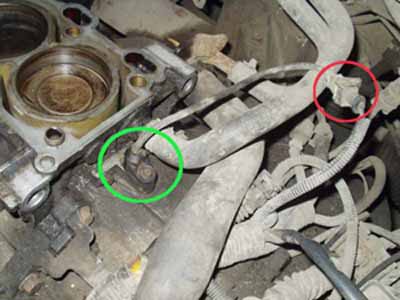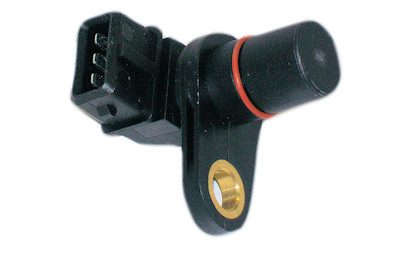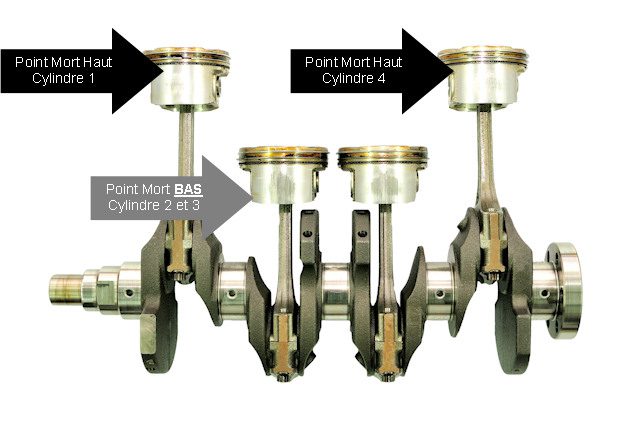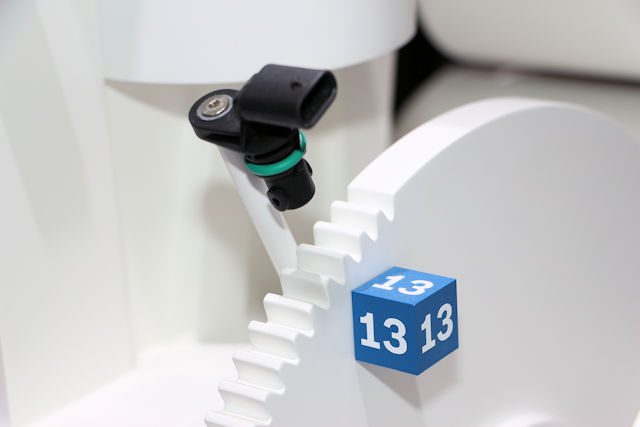
TDC / crankshaft sensor
Content

It is called TDC or crankshaft sensor (located next to the engine flywheel), it informs the ECU about the state of the engine so that it can know when (and how much) fuel needs to be injected. Therefore, when animating several cylinders, it is necessary to control the injectors so that they work at the right time. On a petrol engine, it also lets you know when a spark is generated through the spark plugs (controlled ignition).

Theory and work
Regardless of the type of TDC / crankshaft sensor (inductive or Hall effect), the operation remains more or less the same. The goal is to make a mark on the engine's flywheel to tell the computer the position of all the pistons that make up the engine. Each time the sensor detects a tag, the information is sent to the computer, which then causes the injection to act accordingly.
Each tooth passing in front of the sensor will induce a small electric current (inductive sensors are increasingly being replaced by Hall effect versions). Thanks to this, the computer can count the number of teeth crossed by it and, therefore, follow the rhythm of the motor. After adding this information to the mark, he knows the speed and position of all pistons. For example, in the above diagram, it will know where the TDC of cylinders 1 and 4 is, since it was preprogrammed to be 14 teeth after the mark. Basically, the calculator guesses everything else, relying on a few data provided to it. However, when starting up, the electronics will need a camshaft sensor to know if the TDC of the piston is compression or exhaust ... Finally, note that the notch is not necessarily fewer teeth, it is sometimes found on the flywheel disc. with a sensor attached behind it (on the engine block).


Then the principle of electromagnetism is used: the metal engine flywheel with teeth (it has teeth dedicated to the starter) affects the magnetism of the sensor, which then sends pulses to the computer (for each crossed tooth). As soon as the difference between the two pulses becomes greater, the computer knows that it is at the level of the mark (the place where the teeth are missing).
The computer receives this type of curve (different from the Hall effect versions, the curves are square and the size differences no longer exist) and therefore can determine when and where to inject fuel (but also triggers controlled ignition on essences)
Here is the real curve. The blue is the TDC/crankshaft sensor and the red is the camshaft position sensor.
If the flywheel was made of wood (for example ...), it would not work, because this material cannot influence the electromagnetic field.
Different kinds
- Passive with inductive system : no need for a power supply, the very movement of the flywheel next to it induces a small alternating current. The dataset materializes as a sinusoidal signal that changes in frequency and amplitude (height and width) depending on the motor speed (speed). This type of sensor is more sensitive to stray electromagnetic fields (coming from outside), but cheaper to manufacture. It is endangered.
- Active Hall effect : Power supply required. For each crossed flywheel tooth, it sends a 5 volt signal to the computer. This is no longer a sine curve, but a square plot that resembles a binary code. It consists of a small electronic card that provides dialogue in the same language as the computer. Here, current flows continuously in the sensor: when a tooth passes alongside (the distance between the tooth and the sensor is called an air gap), it slightly disrupts the current passing through it. As a result, we can count the teeth and tell the computer. This type of sensor is more expensive, but represents the next step in the old inductive system as it is more accurate, especially at low speeds.
PMH HS sensor symptoms

Among the most common symptoms, we note a difficult start, engine rattling (a sensor that works intermittently) or untimely stalls while driving ... A faulty tachometer can also be a sign of an inoperative crankshaft sensor.
Sometimes it's just a connection that starts to corrode a little, then just fiddling with the sensor can restore the connection. However, it is best to clean the connectors.
The air gap (the gap between the sensor and the flywheel) could have shifted slightly, due to which the sensor incorrectly determined the position of the crankshaft.
Difference with camshaft sensor / cylinder reference?
The cylinder reference sensor allows, in addition to the TDC sensor, to find out in which phase each cylinder is, namely, in the compression phase (where it will be necessary to produce injection and ignition for gasoline engines) or exhaust (there is nothing to do, just let the gases come out through the exhaust valves). Therefore, when the engine does not have a fuel pump (distribution pump), it is necessary to tell the computer which phase each piston is in, and therefore an AAC sensor is required. More information here.
Change video sensors AAC and PMH
New PMH sensors and AAC position (I'd be lying if I said it was EASY)
Your feedback
Here is the evidence of a faulty PMH sensor (automatically extracted from your latest testimonials posted on the site's test lists).
Porsche Cayenne (2002-2010)
4.8 385 HP 300000 km'2008, discs 20; Cayenne s 385ch : At 300 km starter spark plug sensor PMH steering hose assists kalorstat water pump
Mercedes S-class (2005-2013)
Check engine here S300 turbo D, 1996, 177 HP, BVA, 325000km : problems with the electrician due to faulty wires on PMH, and pneumatic control of door locking (fire in the block).
Mazda6 (2002-2008)
2.0 CD 120 7CV Harmonie / 207.000 km / Diesel / 2006 : - Cylinder head gasket - Flow meter - Sensor PMH– Steering rack – Worn gearbox synchromesh – HS rear power window (brand known issue) – HS trunk lock (brand known issue) – Tends to pull to the right
Renault Laguna 1 (1994 - 2001)
1.9 DTI 100 h 350000km : Sensor PMH and high pressure pump
Peugeot 607 (2000-2011)
2.7 HDI 204 HP BVA : sensor PMH and a booster pump. Plastic hose of the LDR system cat! Put the plastic cooked in the heat! Be careful, empty the gearbox if it is not jerky or even more likely to shift gears in the car!
Renault Clio 2 (1998-2004)
1.4 16v, petrol 98 HP, manual transmission, 180km, 000, tires 2004/175 R65, : If it has trouble starting, you must first clean the sensor PMH who gets dirty with metal dust (this is quite easy to do, look for tutorials on the Internet), at home, which solved the problem. If the air conditioner valve does not work, look at the passenger's feet, there is a plastic ring that breaks, reinforce it, for example, with a surflex (see instructions on the Internet), lock the trunk and the driver's tailgate.
Nissan Primera (2002-2008)
1.8 115ch 180000 : Oil consumption is colossal, 2 liters per 1000 km minimum. PMH and the camshaft should be changed regularly, 4 times every 1 year. An engine that stops regularly until it gets warm.
1.8 hp : Gigantic oil consumption of 2 liters per 1000 km minimum Camshaft sensor and PMH needs to be changed regularly, 4 after 15000 km. Fragile seat fabric.
Renault Laguna 2 (2001-2007)
2.2 dci 150 hp 198.000 km 2003 express finish : the car was bought for 169000 km, it lasted no more than a year, I had an egr valve, a camshaft sensor, a sensor PMH, air conditioner lights, drain (normal), hs start card, diesel siphon does not close, poor radio reception, engine mount, damper that fell overnight, the giveaway finally swallowed my car at a roundabout with over 2000 ¤ of car repair plus side = scrapped
Chevrolet Spark (2009-2015)
1.0 68 ch spark ls 2011, 110000km : apart from the capricious start-up problem for several months (finally solved by simply replacing the sensors PMH and camshaft) there are no real breakdowns. redesigned rear brakes at 95000 km / s to pass MOT, tires, spark plugs (a little difficult due to availability), front pads, oil changes, filters, etc. shorter scheduled maintenance. affordable price of spare parts on the Internet (except for tires of non-standard sizes).
Peugeot 407 (2004-2010)
2.0 HDI 136 HP 407 Premium Pack manual transmission, 6 reports, 157000 km, May 2008 with 17-inch, : Since the display of the mileage of 40 km with dead pixels when changing the mileage, a new part 000¤ + m-½ 89¤. 40 km Replacement of the upper engine mount accessible next to the engine, premature wear of the inner rubber part cost 115 + m-½uvre 000¤ 20 km Replacement of 10 transmitter modules for insufficient tire inflation, one first and then another (one leaked and exploded on my head while re-inflating) 120¤ inflating module + manpower or 000 people in total wears out prematurely towards the end of its service life. You will feel a clicking sound that develops into a burning smell just before it leaves (especially if you drive a lot in the city), it costs 2¤ and I do not recommend replacing it with the same original clutch. Replacing 244 km right anti-roll bar link (which sagged, prematurely wearing out the right rear wheel) ¤488 total 135 km sensor replacement PMH crankshaft (the car makes many strokes and sometimes turns on 3 cylinders instead of 4..) total cost 111¤ Also, I have an engine malfunction that appears 2 to 6 times a year, everything starts suddenly, after which the message “especially ”system faulty” and then nothing, the car drives normally with the engine warning light that goes out after 1-2 days at most, and to date no one has been able to find the cause of the fault (wiring fault or engine servo unit? ?)
Dacia Logan (2005-2012)
1.4 MPI 75 channels : short circuit in the circuit, wiring to the engine
Renault Megane 4 (2015)
1.2 TCE 100 hp : Sensor PMHAir conditioner condenser Stabilizer link Invoice over 2500 ??
Renault Laguna 2 (2001-2007)
1.9 dci 120 ch Mechanical 6-272 km - 000 : power windows (changed 3) Sensor PMH (it is impossible to get a new one, it is necessary to change the beam) the starting map, as 60 million km no longer works to open the doors, even after buying a new one, after that rebelotte 30 million km.
Hyundai Santa Fe (1999-2006)
2.0 CRDI 110 HP Manual / 225500 2002 km / 4 / XNUMXwd “permanent” : Sensor PMH (195000 km / s) Flywheel sensor (200000 km / s) Injectors that remain open (225000 km / s)
Volkswagen Polo V (2009-2017)
1.4 TDI 90 hp Confortline, BVM5, 85000км, 2015 г. : Engine flywheel replaced by 60 km, A / C leak, engine overheating problem, probably related to the gas recirculation radiator, the car left me there several times after the races, there was nothing to do but open the hood and pray, deutsche Qualität !! Low oil level warning light that comes on on motorways for no apparent reason, sensor replacement PMH at an altitude of 84000km
Audi A3 (2003-2012)
2.0 TDI 140 HP sportback since 2012 114000 km : EGR valve Xs I'm getting cold. Clutch or flywheel? I'll go to the garage to check the sensor PMH.
Renault Clio 2 (1998-2004)
1.4 98 h.p. Manual transmission, 237000km, 2004, wheels 14 ″ 175, trim? base! No option! No air conditioner! : Minor problems with ignition coils ... Yellowing of headlights in the early years. More than 10 years later, the sensor PMH, airbag warning light After 230000km, cylinder head gasket, front shock absorbers.
Renault Clio 3 (2005-2012)
1.4 100 chassis BVM5 – 84000km – 2006 : – Ignition coils (80.000 km) – Steering column (65000 km under OUF warranty) – Sensor PMH (83000km) - Temperature sensor (88000km) - Front wiper motor (89000km)
Renault Kangoo (1997-2007)
1.4 petrol 75 hp, manual transmission, 80 km, 000s : mechanical; electrical part (sensor PMH) regulator of idling of the electric motor.
All comments and reactions
Dernier comment posted:
Osman 18000 (Date: 2021, 04:23:03)
I have a Polo 2000 1.4 engine with two camshafts.
Problem: the car starts and then doesn't,
Computer message: engine speed problem '
The engine speed sensor is in good condition.
There is solder on the memory.
Il I. 2 reaction (s) to this comment:
(Your post will be visible under the comment after verification)
Comments continued (51 Ã 65) >> нажмите здесь
Write a comment
What is the MAIN reason you would buy an electric car?